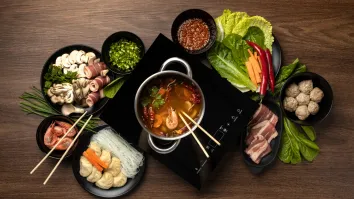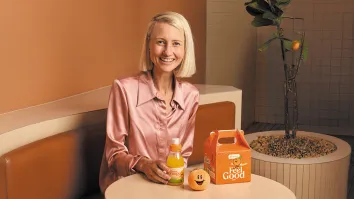
Four foodservice trends that are shaking up Australia's QSR industry
Research from the NPD Group digs deep into the trends of solo dining, free-from foods, and upscale foodcourts.
The macroeconomic fundamentals that serve as the QSR industry’s backdrop has created an increasingly conservative environment for both consumers and businesses.
Sanjev Kangatharan, associate director of the global market intelligence firm The NPD Group, called the country’s QSR market a “1% industry”, owing to its slowing growth and the reactionary mindset of the consumers.
“I would say that it's actually getting slightly slower, because some of those macroeconomic factors are really impacting the millennial consumer, which is the largest consumer in the foodservice environment,” Kangatharan explained at the QSR Media Sandhurst Fine Foods Conference & Awards 2019.
“A lot of families are starting to feel the pinch, and they are also starting to pull back. So it is quite a conservative environment.”
Kangatharan then explored the changing trends and preferences that serve as doors to opportunity.
The changing face of restaurants
As technology continues to dominate and disrupt the industry, the concept of restaurants as they have been in the past is changing dramatically. Nowadays, it is not uncommon to hear news of dark kitchens, or restaurants that are only available through mobile ordering, or virtual kitchens that are augmented by robots and artificial intelligence. Even more common are the grab-and-go counters that populate high-density metropolitan areas like Sydney or Melbourne.
The foodservice outlets that do remain relatively traditional are undergoing major facelifts and renovations or are rebranding to become more premium and upscale. Kangatharan said that it is partly due to consumer preferences shifting towards establishments that place an emphasis on experience.
“Consumers are not really interested in acquiring things anymore, they're more focused on having experiences. And the foodservice environment is very much associated with that,” he said.
This transition is most noticeable in food courts, which have seen a 9% growth in the past year despite accounting for only 8% of all foodservice visits.
The focus for consumers, Kangatharan continued, has shifted towards local flavours, premium product quality, and customer engagement. Whilst 80% of food courts are still made up of chain-led operators because of the challenges facing independent brands, shopping centres are slowly taking advantage of the segment’s growth.
“There is a good chance that we're going to consistently see a conservative consumer for pretty much the vast majority of 2019. So that being said, I would say that the food court segment is a segment that we should consider because it's definitely a segment that is driving growth in a very conservative environment,” Kangatharan said.
Table for one, please
Traffic share of solo dining occasions has significantly increased due to factors such as the fast-paced lifestyle of the contemporary white-collar worker. According to data gathered by the NPD Group, solo dining now comprises 40% of all foodservice visits.
“There have been a number of factors in terms of behavioural changes that have actually caused that to happen. The first thing is obviously the fact that there are a lot of time constraints in today’s mobile lifestyles. We want a lot more “me time”, and also the fact that we always have our mobile phones with us, it destigmatizes the concept of being by yourself in a social setting. Additionally, we're also starting to see an increase in single households,” Kangatharan said.
While off-premises occasions such as drive thru and grab-and-go have the largest share with regard to solo diners, much of the growth has come from on-premises occasions in high population areas, suggesting a shift in urban consumers’ mindset around eating out. Food courts and supermarkets, once again, are playing their part in this growth.
Kangatharan pointed out how Mexican food chains in the US are utilizing this trend of solo diners by providing them with extra servings with their lunch orders, so that patrons have additional food for a dinner-at-home occasion.
“Now, that's a positive on two fronts. Firstly, it increases the average eater cheque. Number two, it increases a sense of brand loyalty from your consumers because it tells them that you're looking out for them,” he said.“And I wouldn't be surprised if there were some operators in Australia who had that type of thought process to really connect with the consumer.”
The ‘free-from’ movement
One common talking point in the industry is the rise of ‘free-from foods’. The definition includes foods that have no added hormones, are health associated such as low salt, and animal welfare considerations such as free range.
The movement has grown in influence significantly in the past two years, and Kangatharan noted that in 2018 there was a slight 1% bump in the segment’s market share, suggesting considerable growth in both consumer traffic and spend.
For operators in the segment, this is good news considering that ‘free-from foods’ consumers have a higher average eater cheque than standard consumers, as well as a higher overall satisfaction rate, according to NPD Group data.
Millennial consumers, that is, consumers who are 18 to 34 years of age, comprise 47% of all meal purchases in the segment. This is particularly significant as millennials make up a significant portion (over 35%) of all foodservice consumers.
Interestingly, Kangatharan pointed out that older generations value provenance and locally-sourced food much more than millennials, who value health as their primary concern when ordering free-from meals, with price as the secondary priority.
As millennial consumers begin to take a larger role in the share of consumer spend in Australia, Kangatharan said that the free-from movement, as well as related movements such as vegetarianism and veganism, will become a much more important driver in the industry’s growth.
“American operators have not just focused on free-from foods, but also on that vegan and vegetarian consumer. And that's quite important here as well, because that consumer has actually grown 4% in the last year. Now, once again, the traffic share is not that high. It's just above 5%. But it is growing, and it is starting to make an impact,” he said.
“I think that a lot of food-based demographics, especially that vegan and vegetarian segment, would have a greater impact through younger demographics, in comparison to older demographics.”
Digital ordering and zero waiting
In contrast to the foodservice’s slow growth rate over the past year, the digital segment has risen by leaps and bounds. Digital ordering made up 5% of all foodservice visits in the last year, equating to 214 million visits, and posted a staggering 75% growth in visits.
Of these visits, websites visited through a laptop or desktop still account for a significant share. However, mobile app and kiosk-based ordering are contributing more to the increase in visits.
Delivery, third party aggregators, mobile ordering, and mobile payment are all seeing double digit growth, Kangatharan said, despite all of them having a lower market share due to their recent introduction into the industry. More than two-thirds or 69% of all digital visits are from operator-owned apps,websites and kiosks, while 31% are from aggregators.
“The key question is, where does the growth come from?” Kangatharan said. “If you look at the growth, then it comes back to the aggregators. It goes to show how fast the aggregators are growing, how aggressive they are, and more importantly, how the dynamics have changed within the foodservice environment ever since the aggregators launched in Australia.”
The significance of digital visits, he noted, is particularly important to the future of foodservice. Not only does this pertain to delivery, but to emerging technology like virtual and augmented reality, robot-assisted services, cashless and cardless payment systems, and enhanced voice ordering.
“In all the 13 markets where we capture foodservice data, the growth of digital-based ordering is the one thing that is common across APAC, the Americas and Europe,” he said.
“There is definitely dynamic growth that will continue to define the digital segment. It is something to keep a watch out for, because it's going to continue to be a significant traffic driver in the foodservice industry.”


























